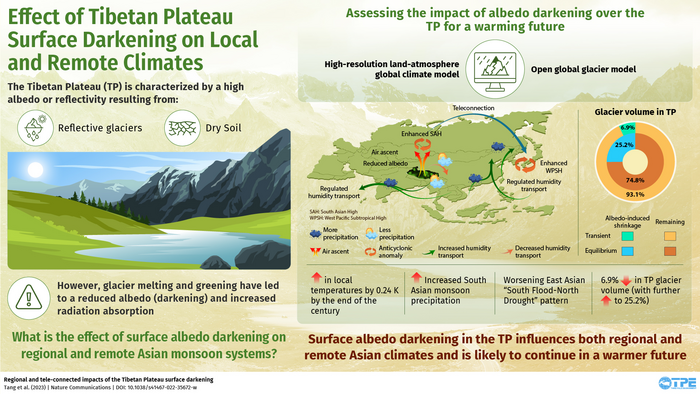Owing to global warming effects, the Tibetan Plateau (TP) region has experienced drastic changes in its land surface, characterized by melting glaciers, loss of snow cover, and vegetation greening. These, in turn, have led to a darkening of the land surface, characterized by a lower surface albedo and higher absorption of shortwave radiation. This has resulted in increased surface temperatures, contributing to the surface darkening. However, the climatic and glaciological effects of such darkening over the TP have not been assessed or quantified.

Credit: Shilong Piao from TPESER, China
Owing to global warming effects, the Tibetan Plateau (TP) region has experienced drastic changes in its land surface, characterized by melting glaciers, loss of snow cover, and vegetation greening. These, in turn, have led to a darkening of the land surface, characterized by a lower surface albedo and higher absorption of shortwave radiation. This has resulted in increased surface temperatures, contributing to the surface darkening. However, the climatic and glaciological effects of such darkening over the TP have not been assessed or quantified.
Against this backdrop, an international team of researchers, led by Prof. Shilong Piao from the Institute of Tibetan Plateau Research at the Chinese Academy of Sciences and the new Third Pole Environment (TPE) leader, set out to investigate how surface darkening over the TP would impact regional as well as remote climates in Asia. Their study was made available online on January 03, 2023, and published in Volume 14 of the journal Nature Communications. “Given that the darkening trend of the TP is likely to continue in a warmer future, it is critical to close the knowledge gap on how it will influence the climate and glacier volume in the TP as well as in other remote regions,” explains Prof. Piao.
The team adopted a high-resolution land-atmosphere global climate model (LMDZOR) and an open global glacier model (OGGM) to study the impact of TP surface darkening under a high-emission scenario. With this setup, they conducted two “experiments” to track the changes. The first was a control experiment with the present albedo values, while the second was a scenario experiment with future albedo values over the TP. Furthermore, they used LMDZOR-simulated near-surface precipitation and air temperatures to drive the OGGM for predicting the albedo-induced glacier melting by the end of the century.
The predictions implied a significant impact of the surface darkening on the surrounding climate. The team’s projections estimated a local temperature increase of 0.24 K by the end of the century. This rise in temperature would, in turn, strengthen the TP’s thermodynamic forcing, causing hindrance to wind and humidity transport over South Asia but simultaneously propelling moist air from the Bay of Bengal to the Indian subcontinent. This, in turn, implied an increase in the monsoon precipitation over South Asian especially Indian subcontinent. Additionally, the local and remote impacts of the surface darkening also included an intensification of the “South Flood-North Drought” pattern in East Asia.
Furthermore, the team noted a 6.9% projected loss in glacier volume (with an estimated increase to 25.2%) along with a significant loss in the western TP region. “These findings underscore the critical impacts of TP surface darkening on the climate and hydrological balances in both local and remote Asian monsoon regions,” remarks Prof. Piao. “With this improved quantitative understanding, our study can help inform policies to reduce the risk of extreme weather events, improve water allocation strategies, and support sustainable development in affected areas. This includes policies for both ecosystem and the human use of freshwater as well as long-term climate policies,” he concludes.
And we sure hope it does!
***
Reference
DOI: https://doi.org/10.1038/s41467-022-35672-w
Authors: Shuchang Tang1, Anouk Vlug2,3, Shilong Piao1,4,*, Fei Li4, Tao Wang4,*, Gerhard Krinner5, Laurent Z. X. Li6, Xuhui Wang1, Guangjian Wu4, Yue Li1, Yuan Zhang6,7,8, Xu Lian1,9 & Tandong Yao4
Affiliations:
1Sino-French Institute for Earth System Science, College of Urban and Environmental Sciences, Peking University, China
2Department of Atmospheric and Cryospheric Sciences, University of Innsbruck, Austria
3Institute of Geography, University of Bremen, Germany
4State Key Laboratory of Tibetan Plateau Earth System, Environment and Resources (TPESER), Institute of Tibetan Plateau Research, Chinese Academy of Sciences, China
5Institut des Géosciences de l’Environnement, CNRS, Université Grenoble Alpes, France
6Laboratoire de Météorologie Dynamique, CNRS, Sorbonne Université, École Normale Supérieure, École Polytechnique, France
7Laboratoire des Sciences du Climat et de l’Environnement, IPSL,
CEA-CNRS-UVSQ, Université Paris-Saclay, Gif sur Yvette, France
8Institut Pierre-Simon Laplace, Sorbonne Université/CNRS, France
9Department of Earth and Environmental Engineering, Columbia University, USA
Contact
International Program Office,
Third Pole Environment (TPE)
Building 3,No.16 Lincui Road,
Chaoyang District,
Beijing, China
Tel: +86-10-84097124
Email: [email protected]
Journal
Nature Communications
DOI
10.1038/s41467-022-35672-w
Method of Research
Computational simulation/modeling
Subject of Research
Not applicable
Article Title
Regional and tele-connected impacts of the Tibetan Plateau surface darkening
Article Publication Date
3-Jan-2023
COI Statement
The authors declare no competing interests




